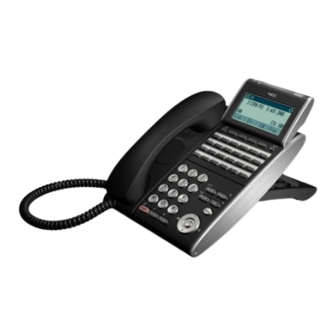
NEC Univerge SV8100 DT730 User Manual
Hide thumbs
Also See for Univerge SV8100 DT730:
- User manual (66 pages) ,
- User manual (69 pages) ,
- User manual (70 pages)
Table of Contents
Advertisement
Quick Links
NOTICE
Note that when converting this document from its original format
to a .pdf file, some minor font and format changes may occur.
When viewing and printing this document, we cannot guarantee
that your specific PC or printer will support all of the fonts or
graphics. Therefore, when you view the document, fonts may be
substituted and your individual printer may not have the
capability to print the document correctly.
Advertisement
Table of Contents

Summarization of Contents
1. Introduction
General
Overview of the guide's scope and content for DT Series telephones.
Face Layout
Illustrates and describes the physical appearance and buttons of different NEC phone models.
Keys And Parts
Details the function of each key and component on the telephone for proper operation.
Icon Display
Explains the meaning of various icons displayed on the phone's LCD screen to indicate status.
Menu List
Lists available menu items and their associated functions for terminal operations and settings.
Simple Operation by Menu Key and Cursor Key
Guides users on navigating menus and accessing features using specific keys.
2. Terminal Setup
Terminal Setup With the Up/Down Key
Adjusts handset receiver volume, ringer tone, and LCD contrast using Up/Down keys.
Terminal Setup With the Feature Key
Configures microphone status, ringer tone, and incoming ring tone using dedicated feature keys.
3. Basic Operation
Login (DT700 Series Only)
Procedure for logging into the telephone system using login ID and password.
Logout (DT700 Series Only)
Steps to log out from the telephone system using the assigned Logout feature key.
To Start Security Mode (DT730 Only)
Instructions to activate security mode on the DT730 model using the Lock key.
To Cancel Security Mode
Steps to deactivate security mode by entering the password or using the Lock key.
4. Feature Operation
Answering Calls
How to answer incoming calls using the Answer key or other available methods.
Placing Calls
Procedures for initiating internal and external calls from the telephone.
Microphone Control
How to turn the microphone on and off using the MIC key, indicated by LED status.
Speakerphone Calls
Steps to initiate and manage calls using the speakerphone function for hands-free operation.
Group Listen
How to enable and use the Group Listen feature for amplified audio during calls.
Holding Calls
Procedures for placing active calls on system or exclusive hold.
Transferring Calls
How to transfer calls manually or using Direct Station Selection (DSS) without attendant assistance.
Conference
Steps to establish and manage multi-party conference calls by adding participants.
Call Park – System
How to park calls in system orbits for later retrieval by oneself or others.
Station Busy/No Answer Options
Features like Callback for busy or unanswered extensions to ensure calls are returned.
Message Waiting
How to leave and retrieve message waiting indications on the telephone.
Tone Override
Procedure to send off-hook signals to a busy extension to interrupt or override the call.
Department Step Call
How to make sequential calls to department group members when the first is busy.
Voice Over
How to initiate and respond to voice announcements to busy extensions for urgent communication.
CO/PBX Dialing Options
Features for saving dialed numbers and memo dialing for quick access.
Repeat Redial
How to automatically redial numbers when the called party is unavailable or busy.
Caller ID
How to view incoming caller information displayed on the telephone.
Temporary Memory
How unanswered calls are stored for later review in call history.
Call Pickup
Procedures for picking up calls ringing at other extensions or groups.
Paging
How to make internal and external page announcements to individuals or groups.
Meet Me Answer
How to join internal or external 'Meet Me' pages for conference-style communication.
Background Music
How to turn background music on or off for the telephone.
Call Forwarding
How to set up and cancel various call forwarding options (Immediate, Busy/No Answer, Both Ring).
Selectable Display Messaging
How to select and display pre-set messages on the telephone's screen.
Station Relocation
Procedure to exchange or relocate telephone terminals to different stations.
Code Restriction, Dial Block
How to set and release dial blocks for restricting outgoing calls by code.
Account Code Entry
Procedures for entering account codes for trunk calls for billing or tracking.
Automatic Call Distribution (ACD)
Instructions for logging in/out as an agent and managing ACD states for call handling.
Queue Status Display
How to view the status of calls within ACD queues, including waiting times.
5. Directory Operation
Add New Data
Step-by-step guide to adding new contacts and phone numbers to the directory.
Find Registered Data
How to search for existing directory entries by name, group, number, or memory ID.
Make a Call From Directory
Procedures to initiate a call directly from a selected directory entry.
Delete All Directory Data
How to erase all saved contact entries from the telephone directory.
Delete Specific Directory Data
Steps to remove a single, selected contact entry from the directory.
6. Call History Operation
View Call History
How to access and review past incoming and outgoing call records on the telephone.
Make a Call From Call History
Procedures to redial numbers directly from the recorded call history.
Store Call History Data to Speed Dial
How to save call history entries to speed dial bins or the telephone book for quick access.
Delete Call History Data
Steps to delete single or all entries from the call history log.













Need help?
Do you have a question about the Univerge SV8100 DT730 and is the answer not in the manual?
Questions and answers